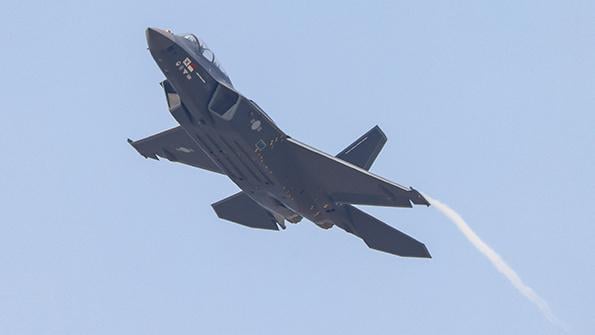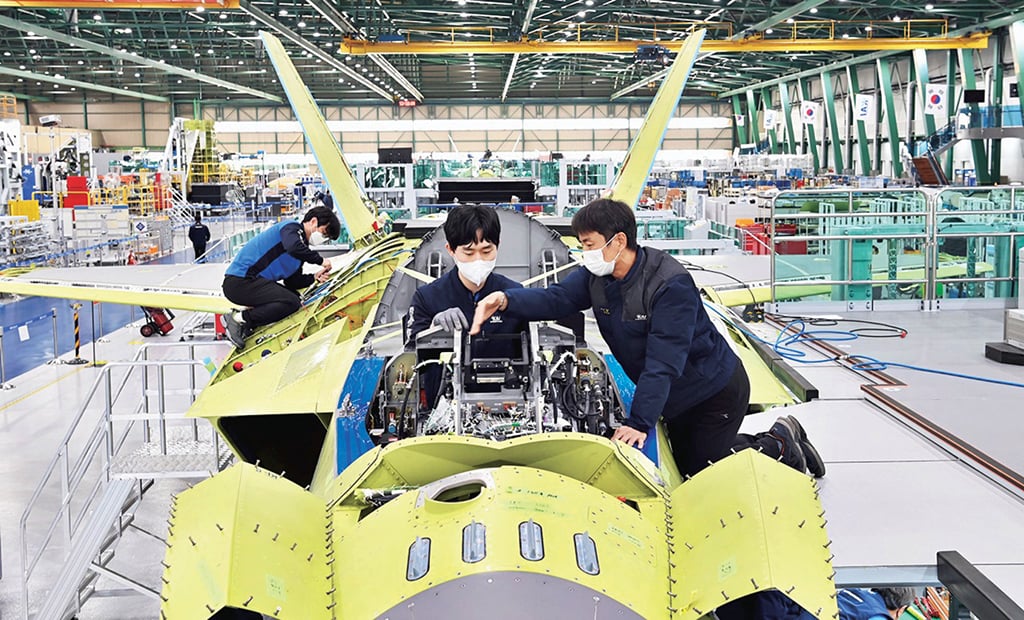
A two-seat KF-21, Serial No. 6, made its public flying debut at the Seoul International Aerospace and Defense Exhibition.
The moment passed quickly, but its meaning was clear. Capping a short, 5-min. performance, the crew of the two-seat KF-21 Boramae test aircraft flew one last high-speed pass over the crowd at the Seoul International Aerospace and Defense Exhibition on Oct. 18, then abruptly pulled up into a high-g climb and rolled three times.
As air show performances go, it was not much. For a young aircraft type that has logged only 300 sorties since a first flight 14 months ago, however, the surprise stunt during its public flying debut sent a message from Korea Aerospace Industries (KAI), the designer of the 4.5-generation KF-21 Boramae fighter: We can do this.
- More than 300 test flights have been completed since last July
- Foreign partners sought for next two development phases
- Full requirements for Phase 3 yet to be defined
Nearly eight years after the start of a scheduled decade-long engineering and manufacturing development (EMD) phase, KAI executives still feel compelled to prove to doubters—both abroad and at home—that the world’s 37th-largest defense company can deliver a modern, midsize fighter with minimal assistance from overseas experts.
“It’s only now, after seeing the stable development that is going on time, that many countries’ armed forces are showing much interest,” Kang Goo-young, CEO of KAI and former deputy chief of staff of the South Korean Air Force, acknowledged to Aviation Week reporters during the exhibition.
Indeed, the KF-21 project has accelerated in recent months after a slow beginning. The South Korean Air Force started working in 2002 on a concept for an advanced, indigenous fighter to follow the KAI/Lockheed Martin F/A-50 Golden Eagle. After a four-year pause to wait for funding approval following completion of a technology maturation phase in 2012, South Korea’s Defense Acquisition Program Administration launched the EMD Phase 1 program in 2016 to deliver a KF-21 with only air-to-air capabilities by 2026.
First flight of the single-seat KF-21 test aircraft followed a respectable 6.5 years after the EMD phase on July 19, 2022. All six Boramae test aircraft, including a pair of two-seaters, entered flight testing within the next 12 months. KAI sprang a few surprise milestones during the interim, including the first supersonic test within the first 80 flights in January and the first air-to-air missile firing three months later. By contrast, the first missile launch test by a Lockheed F-35 came more than six years after the first flight of a weight-optimized test aircraft.
With one-third of a 43-month flight-test schedule for the Phase 1 KF-21 completed, KAI still has much work to do. Eighty-five percent of the scheduled 2,000 test flights remain to be flown, but sorties will likely accelerate with all six test aircraft available.

The KAI program has several natural advantages. Although former KAI Chief Engineer Lee Il-woo designed the KF-21 with Lockheed F-22-inspired caret inlets, hexagonal nose and canted vertical tails, the technology in development for the Phase 1 Boramae is not nearly on the same level.
In addition to relying on off-the-shelf GE F414 engines and mission systems, the KF-21 configuration features mature technologies. For example, a traditional head-up display is installed as a primary source for flight information instead of helmet-mounted displays, Lee told Aviation Week. Rather than attempting to weave conformal electronic warfare antennas into the skin, the KF-21 is designed with protruding blister fairings for high- and low-band frequency coverage, Lee noted. The result sacrifices some aerodynamic performance but reduces the technical challenge for KAI engineers.
Likewise, the seven structural bulkheads in the KF-21’s midfuselage are made with a machined aluminum alloy to save cost and weight, instead of more advanced and heavier titanium structures forged by a 50,000-ton press.
To be sure, the program still faces development risks. Lockheed helped KAI design the T-50 and F/A-50 aircraft, with a team of American engineers working alongside South Koreans. A group of about 60 Lockheed engineers are also supporting the KF-21 now, but the contract with KAI limits them to an advisory and feedback role.
The program is designed to minimize development risks, but the complexity of managing the Boramae is growing. Next year, KAI plans to start production of an initial batch of 40 KF-21s, even as EMD Phase 1 flight tests continue. Ground testing also is to begin soon on the aircraft’s air-to-ground configuration, with munitions to be inducted into vibration testing on the No. 1 test aircraft. A two-year EMD Phase 2, intended to clear the flight envelope in the air-to-ground role, is scheduled to begin in 2026, even as the first operational South Korean Air Force squadron starts flying the Boramae on air-to-air missions.
The program’s toughest challenge will come after 2028. The South Korean military has not defined the full requirements for the EMD Phase 3 program, but KAI expects to adapt the airframe to a stealthy configuration that may include technically tricky new features such as an internal weapon bay, conformal antennas and exterior coatings to absorb radar energy.
A successful Phase 3 could dramatically boost prospects for the KF-21 on the export market, with Poland and the United Arab Emirates among the countries reportedly showing interest. In the interim, South Korean industry officials want to sign up new development partners besides Indonesia, which has fallen behind on Phase 1 progress payments. The Defense Acquisition Program Administration will make the final decision on whether to expand the development partnership.
Any new foreign partners must be able to trust that KAI can follow through on the program’s promises.
“The world, they didn’t buy the idea of the development of a 4.5-generation jet becoming a fifth-generation fighter,” Kang told Aviation Week. “Even during the rollout ceremony, people still had doubts.”







Comments
Now they have a flying testbed that can be modified, first with internal weapons bays and then the conformal apertures and antenna arrays to lower the RCS. Lastly the will have time to work out a durable and effective coating to control RF energy directed at the aeroplane.